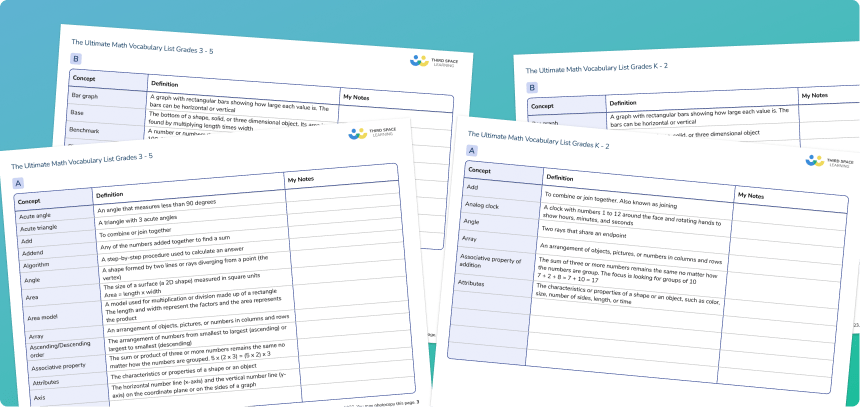Math Talk For the Elementary Classroom: 5 Proven Strategies To Engage Your Students
Do you sometimes struggle to engage students in math talk and expressing their reasoning? You’re not alone if you do. We’ve looked at many different ways to nurture and develop students’ spoken and written mathematical vocabulary. These are some of the most effective activities we’ve used in developing the knowledge and skills of students in the mathematics classroom.
This is a follow-up post to Talking in Math lessons [Part 1]: 5 simple activities to build fluency and develop reasoning skills so it’s worth taking a look at that post first.
Ultimate Math Vocabulary Lists
Download this free math vocabulary list for elementary schoolers to help develop math talk in the classroom
Download Free Now!1. Model how to use the language
Teachers should first provide a clear model of how to use the new vocabulary in context, ideally reinforced with concrete and representational resources. The language should be used at the same time as showing the example to help make the link between the abstract and concrete as clear as possible.
Using resources such as sentence stems throughout the school can help to embed consistent and accurate math language. This can also improve students’ confidence in using math vocabulary.
Find out more about how we use concrete and representational resources to help students with their math in our blog 20 Math Strategies That Guarantee Progress for All Students.
2. Write a script
When new math language is first introduced it can be useful to provide a talking frame to scaffold discussion. This is effectively a short script of one or two sentences that uses a keyword, leaving gaps for the children to fill themselves when applying to different examples. It shows the students exactly how and where the vocabulary is used and is particularly useful for less confident learners.
3. Reinforce, reinforce, reinforce
Recap vocabulary at the start of each lesson and refer back to it throughout. Students need to use the language themselves, so plan as many opportunities as possible in your lessons for students to hear and use the words.
4. Display keywords to catch attention
Rather than having a static math display in your classroom, which can fade into the background and be more like wallpaper, set aside an area as a “math working wall”. This should be as interactive as possible and reflect the learning taking part that week.
The teacher or students can add to it throughout the unit of work, pinning up words, drawings, photos and even objects to build a picture of the learning journey. This provides a place for students to refer to during lessons when they might be unsure about a particular word or concept.
Remember, it doesn’t need to be pretty so it shouldn’t take up too much of your time. This is about providing a resource for the class rather than a beautiful, untouched display.
5. Make time for some 1-on-1 conversation
While partner and group discussions are effective ways of engaging students and providing opportunities for mathematical talk, there are limitations. As the class teacher with 30 children to support, you can’t listen to every discussion at once and regardless of best intentions, planning, and preparation, the conversations between children will not always be taking place at as high a level as you would like.
“Children cannot be expected to bring to a task a well-developed capacity for reasoned dialogue. This is especially true for the kinds of skills which are important for learning and practicing mathematics, such as constructing reasoned arguments and critically examining competing explanations” Strom, D., Kemeny, V., Lehrer, R. and Forman, E. (2001) Visualising the emergent structure of children’s mathematical argument. Cognitive Science, 25, 733–73
As a teacher, talking 1-on-1 with a student can be incredibly effective. It is during these opportunities that teachers can most often see students have that rewarding, lightbulb moment that we know and enjoy so much as teachers, “Oh, now I get it!”
It doesn’t always have to be you doing the 1-on-1 talk – teacher aides can be very skilled at getting students to voice their thinking, and parents can be helpful as well (a letter home to specify the language used in the classroom can make this more effective) – but it does help to build some time in with each child.
When you don’t find the time to talk
It can be frustrating when we run out of time in our math lessons and have no more gaps available in our busy days to fit in important conversations with our students. This is where planned and targeted interventions can have a real impact, especially those interventions like our own 1-on-1 that develop students’ math talk.
I hope you’ve found some of these strategies useful for your own classroom – please let us know what works for you.
Elementary school tuition targeted to the needs of each child.
Do you have students who need extra support in math?
Give your students more opportunities to consolidate learning and practice skills through personalized math tutoring with their own dedicated online math tutor.
Each student receives differentiated instruction designed to close their individual learning gaps, and scaffolded learning ensures every student learns at the right pace. Lessons are aligned with your state’s standards and assessments, plus you’ll receive regular reports every step of the way.
Personalized one-on-one math tutoring programs are available for:
– 2nd grade tutoring
– 3rd grade tutoring
– 4th grade tutoring
– 5th grade tutoring
– 6th grade tutoring
– 7th grade tutoring
– 8th grade tutoring
Why not learn more about how it works?
The content in this article was originally written by a former secondary teacher David Leighton and has since been revised and adapted for US schools by elementary math teacher Jaclyn Wassell.

